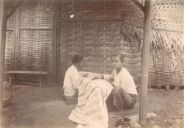Kombinasi
The second cloth shows the second step in the process of making batiks, even though it looks as though it does not differ that much from the first cloth. Only the motif seems to be more visible. The design indicates that this is a sarong, a batik of 1 meter wide and 2 meters long that can be worn as a skirt. The sarong is made up of a kepala (the left side of the cloth), the head, which is usually worn on the front or side, and a badan (the right side of the cloth), the body which makes up most of the surface area.
The motif is more visible here than on the first cloth, because after the cloth is stamped with the Cap, the patterns are redrawn with a canting. On Java this is called ‘Kombinasi’ (combination), as it is a combination of Cap and Tulis. The canting can bring much more detail than the cap.
The motif on this batik is also a combination. The badan has a classic ‘Vorstenlanden’ motif that comes from Yogyakarta and Surakarta, also called Solo, while the kepala has a floral motif, coming from the northern coast of Java. Both areas are located in Middle-Java. In the world of batiks, these motifs made the difference and were combined more and more from the late 19th century onwards.



